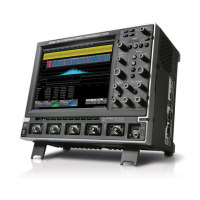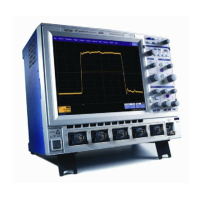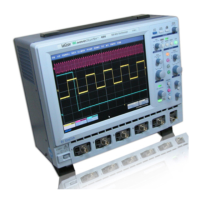374 WM-OM-E Rev I
field is required for Channel Emulation, and it is normally present in the head signal in
every block just after Read Gate goes true, it is recommended that Read Gate be used.
If Read Gate is not present, the entire waveform will be used unless the Analyze
Region cursors are enabled.
• Read Gate Polarity: Typically, Read Gate is a positive true signal. However, there are
drives that use a negative true signal for Read Gate. If Read Gate is enabled, this
setting allows you to select whether "True" is high or low.
• Specify Region: As previously described, markers can be used to define a subset of
the head signal for analysis.
• Filter Head Signal: If enabled, an equalization filter is applied to the head signal
before processing and display. This feature should be used if the DDA does not have
access to the drive’s equalized head signal.
Notes on Using Channel Emulation without Reference
1. Sequenced Amplitude Margin (SAM) is used by the Viterbi detector to decide whether a bit
should be "1" or "0". As the Viterbi detector receives each sample, the detector must
choose between two possible sequences, which lead to the state it selects. The sequence
with the best fit determines which state is selected. SAM indicates how much better the
surviving sequence is than the one that is discarded from further consideration. "0" means
the Viterbi Detector has no preference at all between the sequence it chose and one it
threw away at a particular sample. The most positive value is the square of the "minimum
error distance" for the selected Signal Type, and implies excellent certainty about which
sequence to keep. SAM values are associated with the sample leaving the Viterbi
detector's trellis, that is, the sample about which the final decision is being made. The SAM
includes the effect of all previous samples in the block and of the following samples that are
already in the trellis. Near-zero SAM values are due to distortions in the shape of the head
signal. Problems causing distortions, which Channel Emulation without Reference can find,
include media defects and dropouts, asperities, noise bursts, or a bad head. (Noise bursts
are sometimes obscured by the equalization filter, and result in a distorted shape of a pulse.
To see if this is the cause of a distorted shape, look at the unfiltered waveform also.)
Without a reference Channel Emulation without Reference does not know if the decisions it
makes actually correspond to what was written, it only knows how good the head signal
looks when the disk is read. As an example, suppose a disk occasionally simply fails to
write several transitions, resulting in a flat area in the head signal. All the pulses are the
correct shape, it’s just that some aren’t there at all. This can still be caught if it causes a
Run Length Limit violation and that check was enabled, but it might not be a problem for the
Viterbi detector.
2. When checking for run length limit (RLL) violations, "k" of the RLL code "m/n(d,k)" must be
specified: "k" is the maximum number of non-transitions between transitions. When Run
Length Limit is set to a non-zero value, Channel Emulation without Reference also counts
the number of non-transitions in a row and checks against the user specified limit.
Examples: we recommend that k be set to 8 to handle 8/9(0,4,4) codes; set k to 7 for
2/3(1,7) modulation code.
3. d is the minimum number of non-transitions between transitions. When d=0, adjacent
